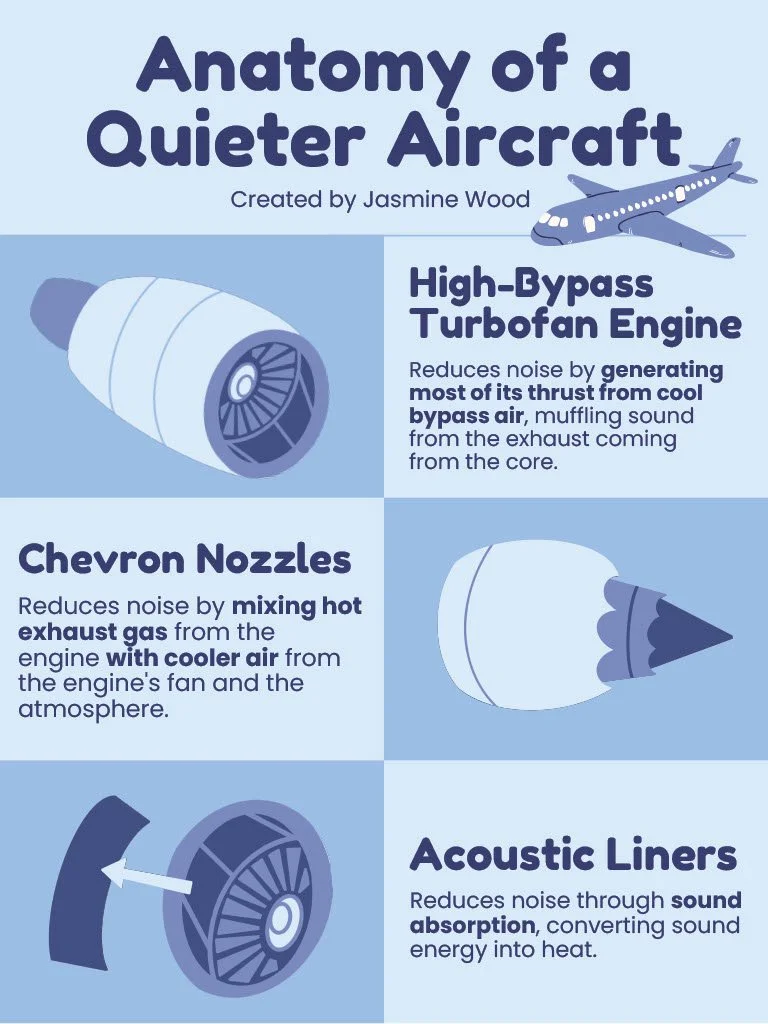The Quiet Revolution
Engineers have made commercial airline engines intentionally quieter
Written by: Sophia Young | Edited by: Sophia Young | Infographic by: Jasmine Wood
Think back to your childhood front yard, playing with your dog or siblings. Do you remember being interrupted by a deafening and intensely mechanical noise? You would have immediately recognized it as a plane and looked up in awe, watching it pass overhead and wondering about where they were heading until the noise subsided. When was the last time you heard a plane? Here in Los Angeles, we hear our fair share of helicopters and planes taking off, but when you aren’t listening for it, and only happen to look up in the sky, there is often a plane. Over the years, engineering advancements and stricter regulations have made the airplanes significantly quieter, muting the skies above us.
What happened? Well, planes used to be loud because of their turbofan design. A turbofan design meant that air would be rushed out the back of the engine at extremely high speeds, making this intense noise. As time went on, it was hard to keep making advancements in the speed of planes, so the focus turned to noise pollution. Complaints and health concerns lead to government noise limits and harder pressure on engineers to fix this issue.
How did they do it? Engineers have created a high-bypass turbofan engine (the large engines you see on most airplanes today). By moving a larger volume of air more slowly, these engines mix exhaust smoothly with surrounding air, cutting jet noise. In addition to the engines, they have implemented chevron nozzles, which are the wavy edges you see on some jet engines, to lower turbulence at the exhaust, softening the sound. Acoustic liners have made an appearance; these are sound-absorbing materials inside the engine compartment that are used to trap noise. Finally, advancements in the landing gear and flaps reduced “airframe noise.” The new shapes and small fairings quiet the whoosh you hear during approach. NASA and Boeing have combined all of these features and have reduced the landing-phase noise by more than 70% in some experiments.
In simpler terms, noise is caused by turbulent air mixing. So we need a smoother flow of air to have less noise. A single modern jet, like a Boeing 787 or Airbus A350, is up to 20 dB quieter than first-generation jets. That’s about 75% less noise energy! By reducing speed differences between air streams and breaking up large vortices into smaller ones, engineers have been able to cut the total sound energy. This is in line with the stages that the U.S. and the FAA have implemented. Older Stage 3 jets are noisier, while newer Stage 4 and 5 models meet the stricter noise standard. These regulations now require airlines to phase out the older and louder Stage 3 aircraft. Through this, the noise footprint around major airports has lowered dramatically, by just about 60% even though air travel is growing every day.
Through wind tunnel and computer simulations, engineers are trying to find designs that minimize noise while keeping performance efficient. Research and goals are being set for even quieter electric or hybrid aircraft and bio-inspired designs, like owl-feather edges that scatter sound. Owls are silent fliers, so imagine those wings on a plane! On a more ambitious wavelength, supersonic jets and air taxis pose new acoustic challenges for engineers to face, posing to be the next frontier of quiet flight. That is a faraway realm of regulations and challenges, so we will have to settle for the commercial speeds for now.
Maybe one day we will travel from Los Angeles to New York City at the speed of sound, but for now, we can appreciate the quieter aircraft. Our neighborhoods have lowered noise levels, which improves sleep, concentration, and quality of life near airports. Other noise abatement procedures, like continuous runway rotation, further reduce disturbance. Still, as air traffic grows, your input remains important to keeping progress on track.
The next time you hear a faint hum of a passing airplane, remember that you are hearing decades of quiet innovation.
These articles are not intended to serve as medical advice. If you have specific medical concerns, please reach out to your provider.

